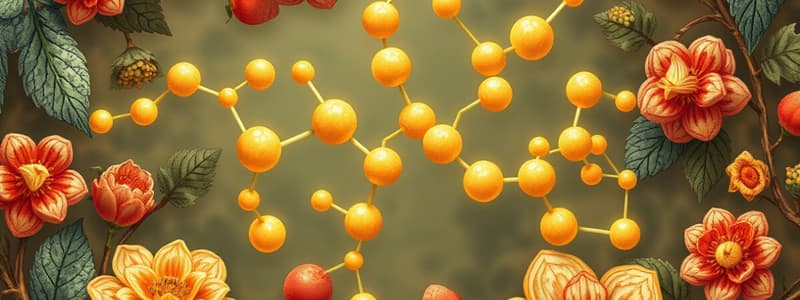Podcast
Questions and Answers
Which of the following molecules is NOT a macromolecule?
Which of the following molecules is NOT a macromolecule?
- Protein
- Fats
- Carbohydrates
- Glucose (correct)
Are we allowed to eat the food in the lab after the experiment?
Are we allowed to eat the food in the lab after the experiment?
False (B)
Which food contains a high amount of carbohydrates?
Which food contains a high amount of carbohydrates?
Rice
Which food contains a high level of protein?
Which food contains a high level of protein?
Which food contains a high amount of lipids?
Which food contains a high amount of lipids?
What type of macromolecules are expected to be in Alice's salad?
What type of macromolecules are expected to be in Alice's salad?
What is a polymer?
What is a polymer?
Which of these is an aldehyde?
Which of these is an aldehyde?
What forms after the glycosidic linkage reaction between glucose and galactose is complete?
What forms after the glycosidic linkage reaction between glucose and galactose is complete?
What color indicates the presence of a high level of simple sugars?
What color indicates the presence of a high level of simple sugars?
Which tube contains only a low level of glucose?
Which tube contains only a low level of glucose?
Which of the following is a carbohydrate?
Which of the following is a carbohydrate?
What is the difference between alpha and beta glucose?
What is the difference between alpha and beta glucose?
What molecule does insoluble fiber refer to?
What molecule does insoluble fiber refer to?
Which tube contains food with a high amount of starch?
Which tube contains food with a high amount of starch?
What do you call a sample for which no response is expected?
What do you call a sample for which no response is expected?
What type of bond links amino acids together in a chain?
What type of bond links amino acids together in a chain?
The linear sequence of amino acids within a protein is considered the ______ structure of the protein.
The linear sequence of amino acids within a protein is considered the ______ structure of the protein.
Which level of protein structure is formed by weak bonds between oxygen and hydrogen atoms within a polypeptide backbone?
Which level of protein structure is formed by weak bonds between oxygen and hydrogen atoms within a polypeptide backbone?
Which of the following is a secondary protein structure?
Which of the following is a secondary protein structure?
What is the purpose of a positive control?
What is the purpose of a positive control?
Which is the positive control of the Biuret assay?
Which is the positive control of the Biuret assay?
Which type of molecule are lipids mostly made of?
Which type of molecule are lipids mostly made of?
Which of these is the structure of trans fat?
Which of these is the structure of trans fat?
Click on a test tube with high fat content.
Click on a test tube with high fat content.
Which food contains carbohydrates, proteins, and fats?
Which food contains carbohydrates, proteins, and fats?
Which sample contains no macromolecules at all?
Which sample contains no macromolecules at all?
Was your hypothesis right?
Was your hypothesis right?
What should Alice add to her salad to provide the missing macromolecules she needs?
What should Alice add to her salad to provide the missing macromolecules she needs?
Flashcards are hidden until you start studying
Study Notes
Overview of Food Macromolecules
- Macromolecules include proteins, carbohydrates, and lipids; glucose is classified as a simple sugar, not a macromolecule.
- Food in the lab should not be consumed after experiments.
Carbohydrates
- High-carbohydrate foods include rice.
- Sucrose is recognized as a carbohydrate.
- Starch can be detected in foods like baked potatoes, indicated by iodine tests.
Proteins
- Protein-rich food example: chicken breast.
- Amino acids are linked together by peptide bonds.
- The primary structure of a protein refers to the linear sequence of amino acids.
- The secondary structure is formed by weak bonds in the polypeptide backbone, leading to shapes like alpha-helices.
Lipids
- Foods high in lipids include butter and milk.
- Non-polar molecules primarily make up lipids. Trans fat is a specific structural type of lipid.
Testing for Macromolecules
- Benedict's reagent indicates simple sugars; a red color signifies high levels.
- A sample with expected results is termed a positive control; it verifies that negative results are valid.
- Biuret assay's positive control is indicated by dark purple samples like the eggs mixture.
Polymers and Complex Carbohydrates
- Polymers are long molecules formed from repeating units. Complex carbohydrates are hypothesized to be present in foods like cabbage salad.
Fiber and Water
- Insoluble fiber refers to cellulose, an essential carbohydrate.
- Water is used as a sample that contains no macromolecules.
Experiment Results and Conclusions
- Hypothesis testing confirms predictions; for example, if the hypothesis regarding macromolecule presence is confirmed correct, additional sources such as eggs and avocado can enhance nutrient profile in a salad.
Studying That Suits You
Use AI to generate personalized quizzes and flashcards to suit your learning preferences.




